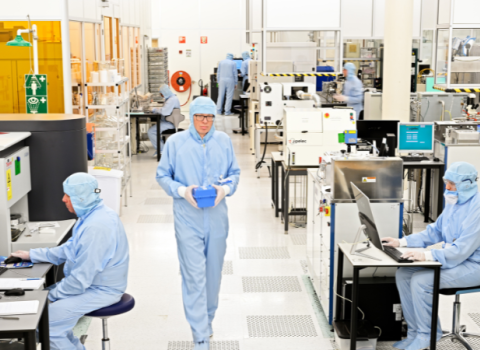Europe is permanently looking to improve its competitiveness. A consensus has emerged that science, technology and innovation is a prerequisite. There is also a consensus that we are lagging behind on innovation. A lack of synergies between stakeholders has been identified as a reason for this, and the term ‘innovation ecosystem’ has been coined as a way of conceptualise the many and various interactions that are required to get innovation moving.
But why not push this analogy further? Engineers have long sought inspiration for their designs in nature. Similarly, ecosystem-like or ‘ecomorphic’ processes can be the inspiration for boosting innovation. Indeed, the fundamentals of Darwinian evolution are a good place to look for lessons in competitiveness.
The earth’s ecosystems did not appear by design, and nature did not become innovative by decree - or by applying complex policies. Nature's overall recipe is amazingly simple: take genetic variability and add competitive advantage-based selection. These principles of ecosystem evolution, in which a flow of new ideas is tested by the trial and error of natural selection, result in amazingly dynamic, complex and innovative results.
Similarly, variability and selection can be viewed as the basic ingredients for improving innovation in the technical world. Genetic variability in a natural ecosystem likened to the way in which fundamental research generates a constant flow of new DNA in the form of data and ideas. These essential ingredients of ‘ecomorphic innovation’ are of course in good supply, with Europe currently generating over 30 per cent of the world’s knowledge.
As in nature, there can be no preconception of the end goal or final design. Rather, an unconstrained approach to basic research is needed to generate the greatest breadth of ideas possible, as the feedstock for innovation.
A gap between ideas and implementation
When it comes to the second principle of ecosystem evolution, namely selection, it is clear that a gap exists between ideas and implementation in Europe. What does the ‘ecomorphic’ analogy tell us? Nature tries out many new options - at first locally - which if successful, expand regionally or even globally. The origin of bird flight, for example, did not need to wait for certification or a global authorisation to proceed.
Compare this to the opening of airspace to space tourism. As soon as the technology was available, the US administration came up with policy adaptations, just in time for the first test flights; opening a path to the next generation air travel. Exactly ten years later, we have not yet started looking into such possibilities in Europe.
Or take another example, autonomous cars. The authorisation for Google to test them locally in Nevada was fast-tracked.
In the US, innovation can happen in a domestic garage, like a new species appearing in a pond. If successful it can easily spread.
Be open to failure
Everywhere or nowhere is a major drawback in European policymaking. What we lack is a smart test case process, to move from basic ideas to proper evaluation of possible applications. For some reason we are not inclined to use the trial and error principle, because failure is not considered to be an option on this side of the Atlantic.
Trying out many options and failing fast – like nature does – should become a new paradigm. For this to happen, a framework is needed to scale up prototyping and experimentation. We must therefore become innovative by creating conditions for local trials of products, services, processes, or even policies; even by enabling temporary exemptions of regulatory barriers. Local societal ecosystems, such as cities or regions, would be ideal test beds.
Validation is not just technical, it also requires acceptance by society. Take the current advances in autonomous aerial vehicles (drones). Why not start with local testing of various technology and regulatory options? In a real-size test case, such as a town, feedback from citizens would provide significant added value. This could improve the lessons learned by crowdsourcing public evaluations and advice that will provide incremental improvements. In addition, citizens may even crowd fund new ideas.
The process could go as far as co-creating or shaping legislation together with citizens. This living-lab approach enables risk-reward evaluation in a real environment, as in the self-organisation of ecosystems.
Publicly funded research is key to de-risking private R&D; likewise, policy experimentation and related crowdsourcing can de-risk innovation.
Seizing opportunity from disaster
The physical environment, with its pressure on resources, acts as a constructive constraint in the incremental evolution of new species. Evolution is not planned; it is not a top-down process. Therefore, in an ever more complex and fast changing world, regulations should be more about monitoring and guidance – acting as a filter – rather than about imposing rules that are not always mature.
One final analogy in support of an ecomorphic approach: every ecosystem can be faced with disasters, but unlike us, nature seizes opportunities in such situations. When dinosaurs disappeared, more room was left for mammals to develop. An economic crisis such as the current one is therefore the right moment to start acting differently. If policy remains too rigid, Europe may become a continent devoid of innovation – in effect a museum of natural history.
Rather than being triggered from the top-down, innovation needs above all to proceed more incrementally - by trial and improvement.
Didier Schmitt is scientific adviser and foresight coordinator in the Chief Scientific Adviser’s Office and in the bureau of European policy advisers to the president of the European Commission. The opinions expressed in this article are those of the author and do not necessarily represent the position of the European Commission.





 A unique international forum for public research organisations and companies to connect their external engagement with strategic interests around their R&D system.
A unique international forum for public research organisations and companies to connect their external engagement with strategic interests around their R&D system.